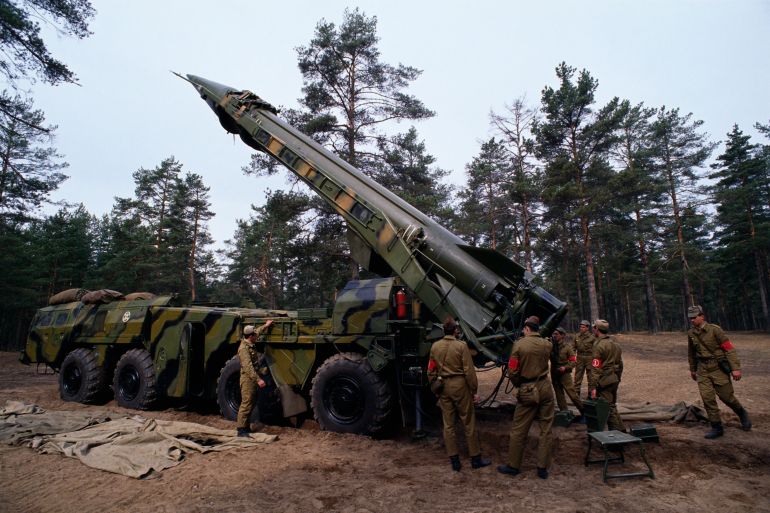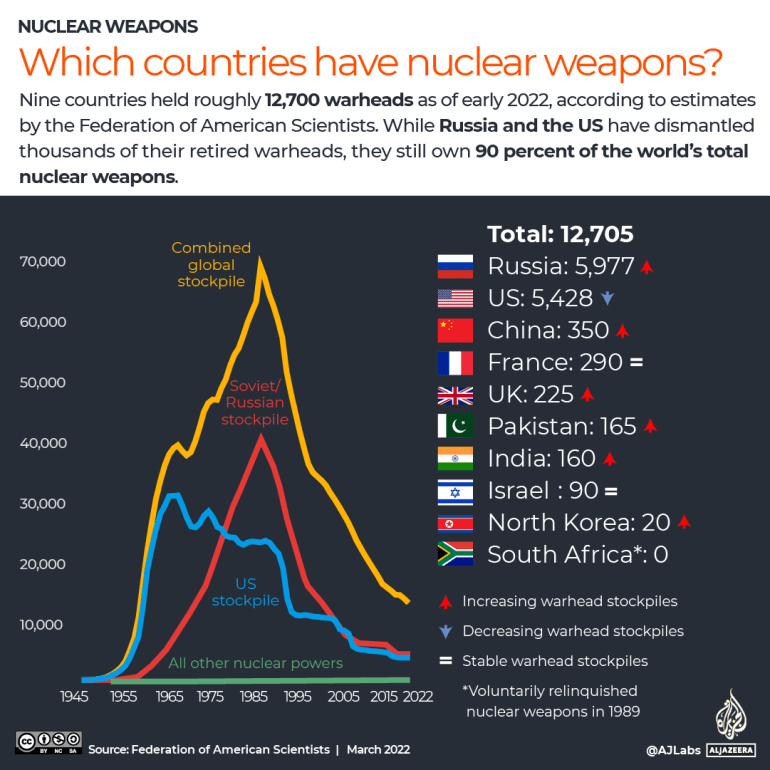What are nuclear tactical weapons, will they be used in Ukraine?
Tactical nuclear weapons are often characterised by their size, range, or use for limited military targets.

US President Joe Biden has said Vladimir Putin is unlikely to use a tactical nuclear weapon in the war with Ukraine, despite earlier threats by his Russian counterpart to “all the means at our disposal” to “defend our land”, including recently annexed Ukrainian regions.
Asked on Tuesday by CNN how realistic it would be for Putin to use a tactical nuclear weapon, Biden responded: “Well, I don’t think he will.”
Keep reading
list of 3 itemsBiden says risk of ‘nuclear Armageddon’ highest in 60 years
Urgent imperative: Zaporizhzhia nuclear plant on auxiliary power
But as Russian troops retreat from the eastern battlefront, the possibility of nuclear weapons being used to stave off defeat, while still slim, cannot be dismissed.
What are the characteristics of tactical nuclear weapons? And why they have drawn so much attention?
What makes a nuclear weapon ‘tactical’?
While there is no universal definition, tactical nuclear weapons are often characterised by their size, their range, or their use for limited military targets.
They are typically many times larger than conventional bombs, causing radioactive fallout and other deadly effects beyond the explosion itself. There is no agreed-upon size that defines tactical weapons.
They are often referred to as “non-strategic weapons”, in contrast with strategic weapons, which the US military defines as designed to target “the enemy’s war-making capacity and will to make war,” including manufacturing, infrastructure, transportation and communication systems, and other targets.
Tactical weapons, by contrast, are designed to accomplish more limited and immediate military goals that win a battle. The term is often used to describe weapons with a lower “yield” – the amount of power released during an explosion.
They can be mounted on missiles, air-dropped bombs, or even artillery shells that have a relatively short range, far less than the huge intercontinental ballistic missiles (ICBMs) designed to travel thousands of kilometres and hit targets across oceans.
“Tactical nuclear warheads were created to give military commanders more flexibility on the battlefield. In the mid-1950s, as more powerful thermonuclear bombs were being built and tested, military planners thought smaller weapons with a shorter range would be more useful in ‘tactical’ situations,” according to Al Jazeera’s defence analyst Alex Gatopoulos.
“Modern warheads have a variable ‘dial-up’ yield, meaning an operator can specify its explosive power, and a tactical weapon would be anywhere from a fraction of a kilotonne to 50kt in strength. For scale, the weapon that destroyed Hiroshima was roughly 15kt. A single kilotonne is equivalent in power to 1,000 tonnes of TNT.”
Who has them?
Many of the world’s nuclear powers have weapons that are considered low-yield or meant to be used on the battlefield.
Russia has 1,000 to 2,000 warheads for non-strategic nuclear weapons in its arsenal, according to a March report by the US Congressional Research Service (CRS).
Putin, who rules the world’s biggest nuclear power, has repeatedly cautioned the West that any attack on Russia could provoke a nuclear response.
The US, he said, had set “a precedent” when it dropped two atomic bombs on the Japanese cities of Hiroshima and Nagasaki in 1945.
The US has approximately 230 non-strategic nuclear weapons, including about 100 B61 bombs deployed with aircraft in Europe.
North Korea this week also went on a missile testing spree, which it said was designed to simulate showering South Korea with tactical nuclear weapons.
Experts believe that if North Korea resumes nuclear testing, it could include the development of smaller warheads meant for battlefield use.
Will they be used in Ukraine?
Biden has expressed doubt that Putin would use a nuclear weapon, but earlier noted that the use of even small nuclear weapons could spiral out of control.
“I don’t think there’s any such thing as the ability to easily [use] a tactical nuclear weapon and not end up with Armageddon,” he said last week.
As Russia flounders on the battlefields of Ukraine, the once-unthinkable possibility of nuclear weapons use is now on the rise.

Tactical nuclear weapons have not been part of strategic thinking since the end of the Cold War in 1991.
“Most of the calculations for how the US and Russia would respond to the use of nuclear weapons have their origins in the Cold War and the delicate ‘Balance of Terror’ that kept the world safe but in fear,” said Al Jazeera’s Gatopoulos.
If Putin cannot come out of this war with something that looks like victory, however, analysts say the chances of nuclear use by Russia to shore up its status as a world power start to grow.